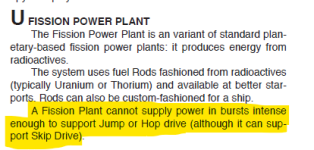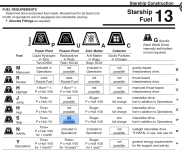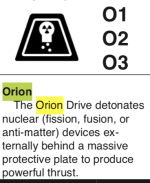You are using an out of date browser. It may not display this or other websites correctly.
You should upgrade or use an alternative browser.
You should upgrade or use an alternative browser.
Fission power and Jump drives.
- Thread starter spank
- Start date
kilemall
SOC-14 5K
I’ll be ignoring that rule.This seems to be a rather odd rule,
Why can't Fission support jump drives?
In what way is the power burst too intense?
How is the requirement for Skip drives different?
I'd be nice if the EP usage was more clearly defined.
View attachment 4422
AnotherDilbert
SOC-14 1K
It's been the same since CT.
All the way to T5:
I have no idea how Skip drives work, or what makes them different...
JTAS#24, p35, "Jumpspace, Required Items":
Power Source: Jump uses large amounts of energy to rip open the barriers between normal space and jump space. Normally, only a fusion power plant can supply this energy. Some alternate systems make use of solar power generators (which operate much more slowly), or anti-matter power systems (rare and very high-tech).
JTAS#24, p36, "Jumpspace, The Typical Jump":
When the jump drive is activated, a large store of fuel is fed through the ship power plant to create the energy necessary for the jump drive. In the interests of rapid energy generation, the power plant does not work at full efficiency, and some of the fuel is lost in carrying off fusion by-products, and in cooling the system. A t the end of a very brief period (less than a few minutes), the jump drive capacitors have been charged to capacity. Under computer control, the energy is then fed into appropriate sections of the jump drive and jump begins.
All the way to T5:
T5.10, B2, p110, "How Jump Works":
The Power System Supplies The Energy Required
The ship’s Power System consumes fuel in an extremely rapid (and inefficient) process, channelling the required energy to the Jump Drive which then “tears a hole in space-time” and inserts the ship into Jump Space.
The actual energy required depends on the Jump Drive, the Power System, and their levels of performance.
I have no idea how Skip drives work, or what makes them different...
Spinward Flow
SOC-14 5K
The difference between nominal "baseline" power for normal space operations and the amount of "surge" power needed for jump is simply too great a difference. A fission power plant can be built for ONE of those applications, but not BOTH (and the one it really CAN'T do is the "surge" power needed).Why can't Fission support jump drives?
In what way is the power burst too intense?
Additionally, it's not like you can just "shovel more fuel" into a fission power plant to cool it down ... unlike what you can do with a fusion power plant.
Yes, the EP rating for both types can be exactly the same ... but as far as suitability for the power demands of jump are concerned, fission and fusion are NOT SYMMETRICAL options for supplying that power demand spike. Hence the rule that fission cannot be used for jump, but fusion can.
Or to put it another way that would be more familiar to contemporary gearheads on this forum.
It's perfectly possible to build an Internal Combustion Engine (ICE) power plant and transmission system that delivers the exact same Power To Wheels output as an Electric Vehicle (EV) set of batteries, motors and "transmission" system. Call it 300hp (ICE) and 300hp (EV) if you need numbers to help illustrate the equivalency I'm setting up here.
Now ask yourself an important question that differentiates the two powertrains from each other rather dramatically.
Q: Which one delivers high torque at ZERO RPMs?
A: Only the EV.
Why?
Because an ICE power plant has a torque curve that has a "different shape" which does not deliver high torque at zero RPMs.
By contrast, the electric power train can deliver high torque at zero RPMs with little (to no) difficulty.
Same max power output (300hp vs 300hp in this illustration example), but the shape of the torque curve at different RPMs is radically different between the two technologies ... and that radical difference creates a performance gap in response to control inputs from the user.
Different engineering technologies "enable" different possibilities in use cases depending on needs.
Fusion power plants can deliver rapid power surges that jump drives need in order to operate (safely).
Fission power plants ... can not.
It's not a matter of "just EPs" ... it's a matter of HOW.
Condottiere
SOC-14 5K
Fusion reactor requirement for jumping seems edition based.
This seems to be a rather odd rule,
Why can't Fission support jump drives?
In what way is the power burst too intense?
How is the requirement for Skip drives different?
I'd be nice if the EP usage was more clearly defined.
View attachment 4422
I have no idea how Skip drives work, or what makes them different...
This *MIGHT* be an errata item left over from an earlier iteration of T5 that got overlooked.
Either in T5.00 or the T5 Alpha-CD (I don't remember which), higher-order hyperdrives not only increased their operational range by successive orders of magnitude in terms of their maximum possible jump distance (and correspondingly greater gravitational-diameter jump-masking limits by intervening celestial bodies) but they also decreased the total travel time of the trip with each successive higher order regime.
So:
- Jump Drive required ~1 week / jump
- Hop Drive required ~1 day / hop
- Skip Drive required ~3.5 hours / skip
It may have been mentioned in the earlier T5 iteration that a "Skip" was of sufficiently short duration that the Fission plant could produce enough energy to support the entire journey (presumably because the EP usage (which is technically power, not energy) for Jump-1 and Skip-1 were the same on the table for a given tonnage, but the Jump-1 had to store a weeks-worth of energy from power-production in the burst, but the Skip-1 only several hours-worth of energy from power-production in the burst).
At least, that is what I think was the case - I may be misremembering. In any event, in T5.10 the shortened higher-level hyperdrive trip durations are no longer a thing.
Spinward Flow
SOC-14 5K
Good, because if it had been kept you'd have "intergalactic travel in minutes" ... at which point you're practically at ansible tech due the lack of "jump lag" between point of origin and destination.At least, that is what I think was the case - I may be misremembering. In any event, in T5.10 the shortened higher-level hyperdrive trip durations are no longer a thing.
Convenience level = HIGH
Respect for Traveller conventions and precedents = LOW
AnotherDilbert
SOC-14 1K
Sorry, I don't understand what you mean.So:
. . . etc. (I believe each regime was about 1/7th the previous regime's duration, IIRC).
- Jump Drive required ~1 week / jump
- Hop Drive required ~1 day / hop
- Skip Drive required ~3.5 hours / skip
It may have been mentioned in the earlier T5 iteration that a "Skip" was of sufficiently short duration that the Fission plant could produce enough energy to support the entire journey (presumably because the EP usage (which is technically power, not energy) for Jump-1 and Skip-1 were the same on the table for a given tonnage, but the Jump-1 had to store a weeks-worth of energy from power-production in the burst, but the Skip-1 only several hours-worth of energy from power-production in the burst).
The duration of the jump/skip is immaterial as all the fuel is consumed and the resulting power spent in a few minutes as the jump/skip is initiated?
T5.10, B2, p118:
The ship’s Power System consumes fuel in an extremely rapid (and inefficient) process, channelling the required energy to the Jump Drive which then “tears a hole in space-time” and inserts the ship into Jump Space.
AnotherDilbert
SOC-14 1K
Spinward Flow
SOC-14 5K
Fission -> M-drives = NOFission not supporting M-drives is quite strange, there is nothing weird going on there?
Fission -> HEPlaR = YES
Easy interpretation would be that Fusion power plants can generate electrical power "relatively directly" (that whole plasma thing...
Also note that Fission power works just fine for NAFAL in ways that Fusion doesn't manage in quite the same way.
Also interesting to see that Collectors are J/H/S "relevant"ONLY and do not deliver enough power for interplanetary or even NAFAL applications.
Condottiere
SOC-14 5K
You can overclock fusion reactors.
Overclocking a fission reactor is a bad idea.
Overclocking a fission reactor is a bad idea.
AnotherDilbert
SOC-14 1K
That would just make Fission plants larger and heavier, wasting more heat. Just as they are (~67% larger).Fission -> M-drives = NO
Fission -> HEPlaR = YES
Easy interpretation would be that Fusion power plants can generate electrical power "relatively directly" (that whole plasma thing...) while fission is mostly a THERMAL process which requires conversion into electricity ... and those conversions are "expensive" in spacefaring applications.
Fission works for NAFAL, not for M-drive, but:Also note that Fission power works just fine for NAFAL in ways that Fusion doesn't manage in quite the same way.
Doesn't make sense...T5.10, B2, p57:
The N-Drive is a powerful version of the maneuver drive that interacts with gravity fields to produce thrust. Performance is evaluated in G (Drive Potential = G/10).
Fusion works fine for NAFAL, it's just the fuel capacity that's a problem.
Same in MgT2, that is the way they work when defined in the rules.Also interesting to see that Collectors are J/H/S "relevant"ONLY and do not deliver enough power for interplanetary or even NAFAL applications.
Sorry, I don't understand what you mean.
The duration of the jump/skip is immaterial as all the fuel is consumed and the resulting power spent in a few minutes as the jump/skip is initiated?
OK. I am home now and am looking through the old T5 materials and have not found a clear reference yet.
What I have found is that in the original T5 Alpha Playtest materials on the 2007 CD, Hop and Skip Drives consumed fuel at 1/10th the rate per drive number that Jump Drives consumed fuel, respectively (Tons = P x Hull / 100). I am not sure how that would translate to a U-Plant (Fission). The note is still there about Fission not being suitable for Jump Drives (et al).
Also, Hop Drive were originally only 1/10th to 1/5th the SIZE of either a Jump or Skip Drive. And Hop-1 was TL23 and Skip-1 was TL26 (and there were no higher order drives above Skip).
From T5 Alpha Disk (2007):
Hop & Skip Drives
- The Mythical “Hop” Drive. Hops are measured in tens of parsecs; the ship Hops exactly that distance; one Hop takes about a day. Fuel usage is relatively small.
- Hop Drive (per Hop). A Hop Drive requires 1% of Hull Tonnage per Hop number (subject to PPlant Overclock) per use. A Hop Drive can perform ONLY a Hop equal to its Potential.
- The Rumored “Skip” Drive. Skips are measured in hundreds of parsecs, but the final distance is inexact. One Skip (regardless of distance) requires several hours. Fuel usage is negligible. A Skip contaminates Jump Space in its originating system, and is subject to SkipScatter.
- Skip Drive (per Skip). A Skip Drive requires 1% of Hull Tonnage per Skip number (subject to PPlant Overclock) per use. A Skip Drive can perform ONLY a Skip equal to its Potential and is subject to Skip Scatter (1 parsec in a random direction from the destination hex).
Fusion P-Plants
OC= Overclock (for Power Plants only; ignore Tons).
STAGE QREBS Experimental Prototype Eraly (Standard) Improved Advanced
OVERCLOCK
Standard P-Plant tonnage is based on Overclock= 100.
True P-Plant tons = Power Plant Tons / (OC/100)
True Hop Fuel Required= Fuel / (OC/100)
True Skip Fuel Required= Fuel / (OC/100)
Overclock is a measure of the efficiency of a Power Plant.
A standard Power Plant operates with Overclock=100 for Potential based on Tech Level.
Power Plants at other TLs have different Overclock.
Overclock affects Power Plant tons and Jump Fuel tons.
TL P-Plant # Overclock [OC] Rate (Historical) 9 10 11 12 13 14 15 16 17 18 19 20 21
How this might affect a Fission power plant (U-Plant) in terms of translating fuel usage to power generated for a Fusion P-Plant, I am not sure.
Last edited:
Overclocking a fission reactor is a bad idea.
But it makes a great Reaction Drive.
AnotherDilbert
SOC-14 1K
Once...But it makes a great Reaction Drive.
Condottiere
SOC-14 5K
This is where we circle back to the Slim Pickens reference.
Spinward Flow
SOC-14 5K
But it makes a great Reaction Drive.
Once...
But it makes a great Reaction Drive.
Not if you make it modular, discrete, and sequential.Once...
And add a pusher plate and massive shock absorbers.
Project Orion (Wikipedia)
AnotherDilbert
SOC-14 1K
Similar threads
- Replies
- 64
- Views
- 5K
- Replies
- 274
- Views
- 14K
- Replies
- 82
- Views
- 7K



